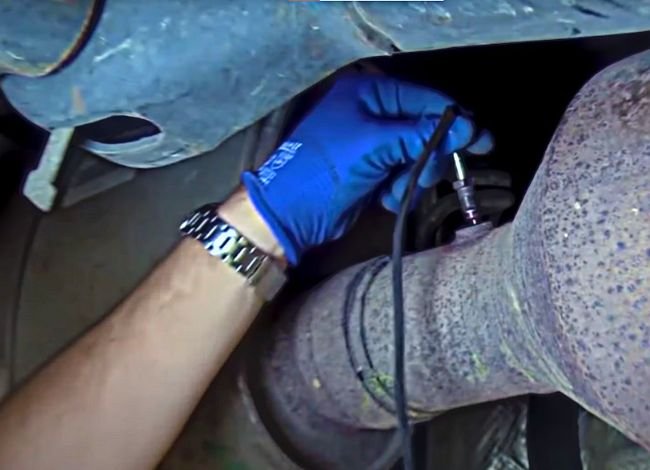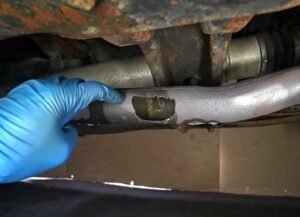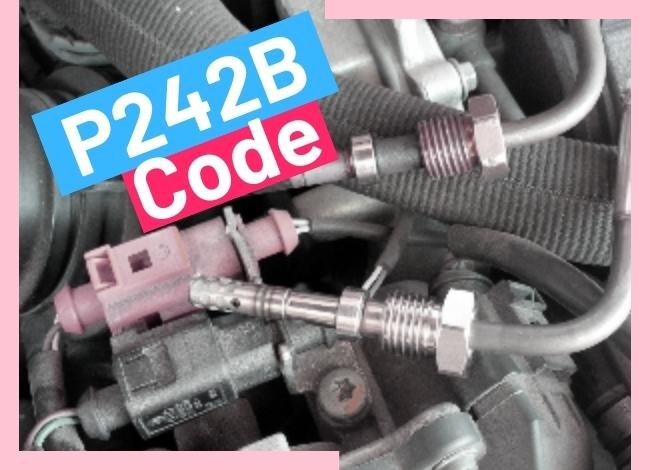Last Updated on July 14, 2025
The P242B code is a diagnostic trouble code (DTC) that refers to “Exhaust Gas Temperature Sensor Circuit Range/Performance Bank 1 Sensor 3.” This code is part of the generic OBD-II powertrain codes and is commonly triggered under unfavorable operating conditions. It specifically relates to the exhaust gas temperature sensor located in Bank 1, Sensor 3—typically positioned after the diesel particulate filter (DPF).
This sensor plays a vital role in monitoring exhaust temperatures to optimize emission control systems, particularly in diesel engines. It ensures the exhaust gas recirculation (EGR) system functions efficiently by helping reduce combustion temperatures and suppress harmful nitrogen oxide (NOx) emissions. When the powertrain control module (PCM) detects that the sensor output is out of the expected range or performing erratically, it logs the P242B code and typically activates the Check Engine Light (CEL) or Malfunction Indicator Lamp (MIL).
Exhaust Gas Temperature Sensor Overview and Its Role in the P242B Code
The Exhaust Gas Temperature Sensor (EGTS) is a critical component in modern engine management systems, especially in vehicles equipped with diesel engines. It is commonly installed in the exhaust manifold, downpipe, or near the EGR or DPF system. In the case of the P242B code, the sensor in question is Bank 1 Sensor 3, which is typically the post-DPF sensor.
How It Works:
The EGTS measures the temperature of exhaust gases and sends that data to the Powertrain Control Module (PCM). This helps regulate the function of systems like:
- EGR (Exhaust Gas Recirculation)
- DPF regeneration
- SCR (Selective Catalytic Reduction)
The sensor is built with a temperature-sensitive resistor. As temperature rises, the sensor’s resistance changes, which alters the voltage signal sent to the PCM. If this voltage falls outside the acceptable range, the PCM interprets it as a sensor fault—thus triggering the P242B code.
Technical Specifications:
- Operating Temperature: Up to 1100°C (2012°F)
- Typical Supply Voltage: 5V
- Sensor Current: Up to 2.7 mA
- Circuit Resistance: Approximately 1000 ohms
- Sensor Features: Moisture-proof sealant, flexible pigtail connectors for high vibration areas
Symptoms of the P242B Code
When the P242B code is triggered, your vehicle’s onboard diagnostics system detects a problem with the exhaust gas temperature sensor’s circuit range or performance. While the check engine light (CEL) is the most noticeable warning, this error code can lead to a variety of performance and emissions-related issues.
Common Symptoms of the P242B Code:
- Illuminated Check Engine Light (CEL)
The most immediate symptom is the activation of the Malfunction Indicator Light (MIL) or check engine light. It signals that the ECM has stored the P242B code due to abnormal sensor readings. - Increased Emissions
When the exhaust gas temperature sensor fails, the engine may run rich or the DPF regeneration process may not function properly, resulting in excessive emissions. This could lead to failed emissions tests. - Unusual Exhaust Odor or Smoke
A strong odor or unusual smoke (black, white, or gray) from the exhaust pipe can be a sign that the temperature sensor is failing and the engine is not properly controlling combustion or exhaust filtering. - Poor Fuel Economy
The engine may compensate for incorrect temperature readings by adjusting the fuel-air mixture inefficiently, causing a drop in fuel efficiency. - Engine Noise or Rattling
Inconsistent combustion and poor exhaust gas flow can lead to engine knock or metallic rattling noises from under the hood or around the exhaust system. - Reduced Engine Performance
If the sensor failure affects EGR or DPF operation, the PCM may enter a safe/limp mode to protect engine components, resulting in sluggish acceleration and reduced power.
Common Causes of the P242B Code
The P242B code is triggered when the Powertrain Control Module (PCM) detects that the exhaust gas temperature sensor (Bank 1, Sensor 3) is operating outside of its expected range. This can result from various mechanical or electrical issues within the exhaust and emissions control systems.

Below are the most common causes of a P242B code:
1. Faulty Exhaust Gas Temperature Sensor
The sensor itself may be damaged, degraded by heat over time, or simply fail due to internal electrical faults. This is the most common reason for this code.
2. Damaged Wiring or Connector
Heat exposure, corrosion, or physical wear can cause the sensor’s wiring harness to short, ground, or disconnect. Loose or frayed wires are a frequent culprit, especially near high-heat areas like the DPF.
3. Poor Electrical Connection in Circuit
An intermittent or high-resistance connection between the sensor and the PCM can cause fluctuating voltage readings, confusing the computer and triggering the P242B code.

4. Exhaust System Leaks
Leaks near the exhaust manifold, EGR valve, or DPF can cause incorrect temperature readings, leading the PCM to believe the sensor is out of range—even if the sensor is working correctly.

5. Excessive Soot or DPF Blockage
If the Diesel Particulate Filter (DPF) is clogged or not regenerating properly, it can cause higher-than-normal temperatures in the exhaust system. The sensor may then read extreme values or operate beyond its design range.
6. Outdated PCM Software
Some vehicles may suffer from outdated PCM firmware that misinterprets temperature sensor signals. An ECU software update may be required to correct the logic used in reading the sensor data.
7. Failed EGR System
A malfunctioning EGR valve or cooler can cause temperature fluctuations and affect the performance of the exhaust gas temperature sensor, especially under load or during regeneration cycles.
Diagnosing and Fixing the P242B Code
Proper diagnosis is essential to accurately fix the P242B code and prevent future issues. Below is a step-by-step guide to troubleshoot and resolve this error:
✅ Step-by-Step Diagnosis and Repair
1. Check for Trouble Codes
Use a reliable OBD2 scanner to pull any stored DTCs. Note any additional codes that may be present, especially those related to the EGR or DPF systems.
2. Visual Inspection
Inspect the exhaust gas temperature sensor (Bank 1, Sensor 3) for visible damage. Check the wiring harness and connectors for melting, corrosion, or wear due to extreme heat.
3. Test Sensor Resistance
Use a digital multimeter or ohmmeter to test the resistance of the sensor. A healthy exhaust temperature sensor should show decreasing resistance as the temperature rises.
4. Inspect for Exhaust Leaks
Check for any leaks around the exhaust manifold, EGR valve, or DPF. Leaks can cause inaccurate readings, triggering false sensor faults.
5. Check Sensor Voltage
With the ignition on (engine off), test the sensor’s signal voltage. It should typically fall between 0.2V and 4.5V depending on temperature. Anything outside this range may confirm a faulty sensor.
6. Replace Faulty Components
If the sensor or its wiring is found to be faulty, replace them. Use only OEM or high-quality aftermarket parts compatible with your vehicle.
7. Update PCM Software
In some cases, the PCM (Powertrain Control Module) software may require an update. Visit your dealership or authorized repair facility for reprogramming if necessary.
8. Clear the Code and Test Drive
After repairs, clear the code using the scanner. Perform a test drive to ensure the P242B code does not return and that the check engine light remains off.
Related Trouble Codes Similar to P242B
Understanding related codes can help in diagnosing complex exhaust system issues. Here’s a comparison of similar DTCs:
| Error Code | Meaning |
|---|---|
| P242A | Exhaust Gas Temperature Sensor Circuit Bank 1 Sensor 3 |
| P242D | Exhaust Gas Temperature Sensor 3 Circuit High Voltage |
| P242E | Exhaust Gas Temperature Sensor 3 Circuit Intermittent Bank 1 Sensor 3 |
| P242B | Exhaust Gas Temperature Sensor Circuit Range/Performance Bank 1 Sensor 3 |
Frequently Asked Questions (FAQs)
❓What does the P242B code mean?
It indicates that the exhaust gas temperature sensor (Bank 1, Sensor 3) is reporting values that are out of range or not performing as expected. It affects emission control and engine performance.
❓Can I drive with a P242B code?
You may be able to drive short distances, but it’s not recommended. Prolonged driving can lead to DPF damage, increased emissions, and reduced fuel efficiency.
❓Is the P242B code serious?
Yes. It directly affects your emission system, and in some cases, the PCM may activate limp mode to protect the engine. Ignoring it can lead to costly repairs.
❓How much does it cost to fix a P242B code?
Repairs typically range from $100 to $300, depending on whether you’re replacing the sensor or wiring. Dealer-level PCM reprogramming may add to the cost.
❓Can a dirty DPF cause a P242B code?
Yes. A clogged or improperly functioning Diesel Particulate Filter can affect exhaust temperatures, triggering incorrect sensor readings and setting this code.
Final Thoughts
The P242B code shouldn’t be ignored—it affects engine performance, emissions, and long-term reliability. Whether it’s a sensor fault, wiring issue, or an exhaust leak, prompt diagnosis and repair are essential. By understanding this code and acting quickly, you can avoid costly repairs and keep your vehicle running smoothly and efficiently.

